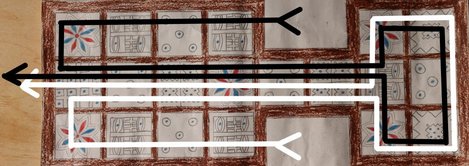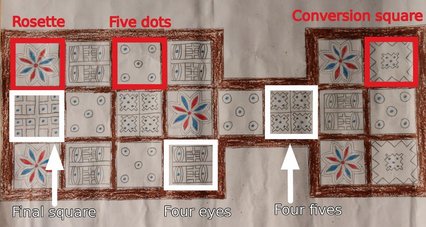Simple rules for Royal Game of Ur using special markings (Dmytro's Ur)
My aim was to create the simple, playable, fun and as close to authentic as possible rule set which uses all the special markings found on Royal Game of Ur board. This is not a modern take on Game of Ur, this is more of an attempt to reconstruct the rules as they could have been played, based on the board design. I was inspired by other rule variants, such as Finkel rules, Walker rules, Ben’s Ur and rules by Skyryuk.
Dmytro’s Ur Rules
Basic mechanics of the game is similar to all other variants: players throw dice, move their pieces on board along the path, single opponent piece may be hit.
Each player gets 7 two-sided pieces, which start off-board. Historically pieces were plain on one side and dotted from another, but any differentiation will do. All pieces start their path as plain.
Players use three 2D dice - which originally should be tetrahedron dice with two white and two black vertices, but coins or other two-sided things can also serve the purpose. Number of white vertices thrown determine how many spaces a piece can be moved. Zero white vertices (all black) means a player should move his piece 4 spaces. Player has to move if is able to do so. If he is unable to do so, his move is lost.
Players move their pieces along the path shown on the picture.

To differentiate pieces which go one way or another, pieces are turned over as soon as they pass or land on a “Conversion square” (13th square on the path).
Meanings of different markings on the squares follow.

Rosette: if a piece lands here, a player is awarded with another dice throw. Note: additional dice throw may be awarded several times in a row, as long as a player continues landing his piece on a Rosette square.
Conversion square: pieces which land or pass over the conversion square are turned over, thus becoming dotted pieces.
Five dots square has no special meaning.
Next three types of squares are safe. Pieces standing there cannot be hit. All of them may accommodate up to four pieces of any color with the following restrictions.
Four eyes square: only plain (unconverted) pieces can stay on the square. This means that dotted pieces can’t move there.
Four fives square: only dotted (converted) pieces can stay on the square. This means that plain pieces can’t move there.
Final square: there are no restrictions on type of pieces which can stay there.
Note: pieces standing on any of these safe types of squares (“Four eyes”, “Four fives” and “Final”) do not block each other from moving away from it. To clarify the point of “any color can occupy the square” - this means that if a black piece is already situated on the square, a white piece may also enter it, as soon as there is a place for it. When four pieces already stay on this square - no other piece may land there.
If a piece occupies a non-safe square (Five dots, Rosette and Conversion) it can be hit by an opposing piece and sent to the players reserve. This piece may later reenter the game. Piece being plain or dotted makes no difference in hitting rules. Player cannot hit pieces of his own color.
Pieces exit the board on the exact throw. This means a player should throw exactly 1 when staying on the “Final square” to exit and so on. A player who is first to move all seven pieces from board wins.
Short rationale
Characteristics of the path in the game is that a Rosette is found on every fourth square. Rosette is the only square which consistently appears on all board design, so its placement should be significant.
Rosette squares are situated exactly 4 dice throw apart from each other. The best explanation for this square is that it awards an additional throw (a very lucky streak of six consecutive fours may allow a player to move one piece out of the board). There’s no need for safe squares on a home row, so I assumed that they were not safe.
To differentiate pieces from moving to different sides, there should be some indication. Since the pieces are originally two-sided, turning the piece over is the obvious thing to do. “Conversion squares” are situated roughly where the turning the piece over should happen. And the design also indicates that something “dotted” should happen. Turning a piece to the dotted side is a consequence of both square position and design.
All three “safe” squares have a four-sided symmetry, which lead me to assume that more pieces could stay there. The “Four fives” or “Five dotted pieces” square is the most obvious one. Its design indicates that four dotted pieces may stay there. This also means that plain pieces cannot stay there. If four pieces can stay there, then they should be safe.
There are four “Four eyes” squares on home rows. Comparing it to the rules for “Four fives” square, I assume that four plain pieces may stay there. This also means that dotted pieces cannot stay there.
The final square is on important crossroad - plain pieces move to the main path, dotted pieces move away from the board. I assume that it must be similar in its function to the other safe squares. Therefore, both type of pieces may stay on this square - since it is an important square for both type of pieces.
These rules are pretty simple and consistent. There are no exceptions. Squares have obvious meaning and are logically situated on board. “Eyes” allow collecting pieces before exiting to the main road. Main road is much safer for the dotted piece (three safe squares along the board) comparing to the plain piece (only two and very far apart) - which makes lots of sense. There is room for strategy and tactics. Throws 1 and 2 happen three times more often than 3 and 4, which allows for strategic pieces placement.
Most importantly - these rules were play tested and were shown as playable and fun.
Textual description of the path and the fields
|-----|-----|-----|-----| |-----|-----|
|ROSE |4 | |4 | |ROSE |CONV |
| |EYES | |EYES | | |SQRE |
|-----|-----|-----|-----|-----|-----|-----|-----|
|FINAL| |4 |ROSE | |4 |4 | |
|SQRE | |FIVES| | |FIVES|EYES | |
|-----|-----|-----|-----|-----|-----|-----|-----|
|ROSE |4 | |4 | |ROSE |CONV |
| |EYES | |EYES | | |SQRE |
|-----|-----|-----|-----| |-----|-----|
|-----|-----|-----|-----| |-----|-----|
| | | | | | *--<--* |
| | | | | | | | | |
|-----|-----|-----|-----|-----|-----|--v--|--|--|
<-------------------------<----------------* | ^ |
| *------------------>----------------* | | |
|--|--|-----|-----|-----|-----|-----|--|--|--|--|
| ^ | | | | | v | | |
| *----------------------<----- | *-->--* |
|-----|-----|-----|-----| |-----|-----|
If for any reasons pictures do not load for you, these are the approximate text description of the path and square names.
Pieces start their way from their respective four “home” squares according to the dice throw, with the “four eyes” square being the first one; then they turn to the main path and move 7 squares there; turn to their closest Rosette (“flower”); go around the 2x3 squares part of the board to the farther Rosette; move back to the main path and move 7 squares back.
Rosette are the “flower” squares, there are 5 of them. Conversion square looks like five dots surrounded with a zigzag line, 13th square on the path, and there are two of them. Five dots square looks exactly as it sounds.
Four eyes square has four eyes depicted on them, there are five of them, with only one on the main path and four others in players “homes”. Four fives squares look like four five-dotted pieces side by side, there are two of them - both on the main path. Final square is easy to spot, because there’s only one square with this design.
Possible modernization of rules
First player who moves 6 (or even 5) pieces off board wins. This is because playing with a single piece left may be boring.
Last pieces may move out on non-exact throws, similar to how backgammon handles this. In other words - the piece, which is the farthest from exiting may exit on a non-exact throw.
These rules on BoardGameGeek